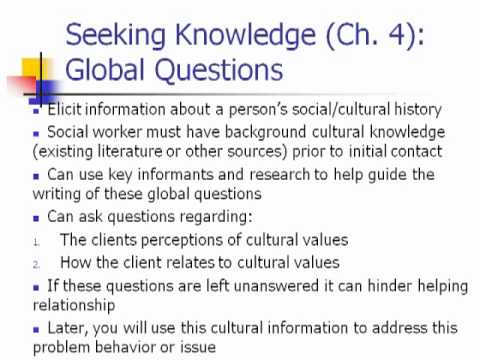MIN 5218 Preparing the Ethnographic Interview
What does culture mean to you?
Culture alludes to the total store of information, experience, convictions, values, perspectives, implications, progressions, religion, ideas of time, jobs, spatial relations, ideas of the universe, and material items and assets obtained by a gathering of individuals throughout ages through individual and gathering endeavouring.
Culture is the framework of information shared by a generally enormous gathering of individuals.
The Right Questions: Ethnographic Questions
Ethnographic interviews employ descriptive and structural questions. Descriptive questions are broad and general and allow people to describe their experiences, their daily activities, and objects and people in their lives. These descriptions provide the interviewer with a general idea of how individuals see their world. Structural questions are used to explore responses to descriptive questions. They are used to understand how the client or parent organizes knowledge. Interviews begin with descriptive questions, such as those shown in the sidebar on page 5. Typically, the interviewer begins with a grand tour (“Tell me about a typical day”) or mini-tour questions (“Tell me about a typical mealtime” or “Tell me about a typical therapy time”).
Responses to the descriptive questions will enable the interviewer to discover what is important to clients or their families. As interviewers listen to answers to descriptive questions, they begin to hear words or issues repeated. These words or issues represent important categories of knowledge. The interviewer wants to understand the relationships that exist among these categories. Nine relationships can capture the majority of the relationships that exist in people’s lives (see sidebar, below right, for examples of each type of structural question). For example, Sarah frequently mentioned being “overtaxed.” The interviewer then asked structural questions to explore Sarah’s concept of being overtaxed. “What kinds of things do you do when you are feeling overtaxed?” “What are the reasons you are overtaxed?” “What are ways to keep from being overtaxed?”
The strict inclusion, rationale, and means-ends questions tend to be used the most. As you begin to do ethnographic interviews, these three types of structural questions are good ones to learn first. Strict-inclusion questions help you gather information on the categories a person is using to organize information (e.g., kinds of memory problems Sarah experiences, kinds of activities Jay wants to participate in). Means-end questions lead to information on behaviors (e.g., ways Sarah deals with feelings of isolation, ways Dora deals with Paul’s tantrums). Rationale questions lead to information on causes of or reasons for the behavior (e.g., reasons for Sarah’s feeling overtaxed, reasons that Jay rejected hearing aids as a child, causes of Paul’s tantrums).
By conducting an ethnographic interview, the interviewer is attempting to gain a good understanding of the social situations in which clients and their families exist and how they perceive and understand those situations. Every social situation has nine dimensions that include people involved, places used, individual acts, groups of acts that combine into activities or routines, events, objects, goals, time, and feelings. Although these dimensions can be discussed separately, in real life, the dimensions interact. People engage in acts, activities, and events in places using objects associated with the activities, events, and locations. The activities and events generally have a time sequence. People engage in them for a reason—that is, they have goals for doing what they do, and they have feelings for what they do, where they do it, and the people involved.
A complete understanding of a client’s or family’s world would involve investigation of all of these areas. For purposes of assessment and intervention planning, however, not all of these dimensions will be of equal importance to every person. Some dimensions will be more important for some clients and families than others. For Sarah, the many people (children, ill husband, husband’s ill mother) depending on her was a critical dimension that affected her ability to function well. For Jay, the activities in which he wished to participate and his goals to contribute to AIDS education were important dimensions that influenced his realization that he needed to be able to hear. And for Dora, Paul’s mother, events such as family celebrations were problematic, reminding her that her child was different and stressing her as she tried to manage Paul’s behaviors in overstimulating environments.
